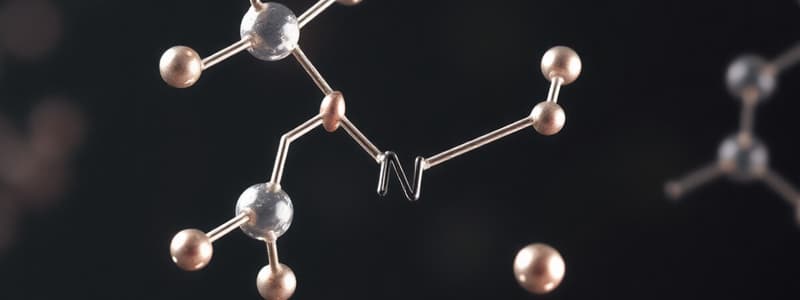Podcast
Questions and Answers
The nucleophilic S atom of Met reacts with CNBr to form a cyclic sulfonium ion.
The nucleophilic S atom of Met reacts with CNBr to form a cyclic sulfonium ion.
False (B)
C-terminal homoserine lactone residues appear at the locations where M residues were cleaved.
C-terminal homoserine lactone residues appear at the locations where M residues were cleaved.
True (A)
Hydroxylamine is used to selectively hydrolyze N-G bonds at a basic pH level.
Hydroxylamine is used to selectively hydrolyze N-G bonds at a basic pH level.
True (A)
Comparing overlapping peptide sequences is not necessary to validate the accuracy of the overall amino acid sequence.
Comparing overlapping peptide sequences is not necessary to validate the accuracy of the overall amino acid sequence.
The overall amino acid sequence of catrocollastatin-C is derived from a single fragmentation procedure.
The overall amino acid sequence of catrocollastatin-C is derived from a single fragmentation procedure.
Electrospray Ionization (ESI-MS) involves the formation of small, highly charged droplets from a liquid protein solution.
Electrospray Ionization (ESI-MS) involves the formation of small, highly charged droplets from a liquid protein solution.
Mass spectrometry technology is primarily used for determining nucleic acid sequences rather than protein sequences.
Mass spectrometry technology is primarily used for determining nucleic acid sequences rather than protein sequences.
MALDI-TOF MS is one of the most prominent modes for analyzing proteins by mass spectrometry.
MALDI-TOF MS is one of the most prominent modes for analyzing proteins by mass spectrometry.
One of the steps in ESI-MS includes the separation of ions based on their mass-to-charge ratios in a room-temperature environment.
One of the steps in ESI-MS includes the separation of ions based on their mass-to-charge ratios in a room-temperature environment.
The fragments produced in a mass spectrometer can provide specific structural information about a molecule.
The fragments produced in a mass spectrometer can provide specific structural information about a molecule.
Flashcards are hidden until you start studying
Study Notes
CNBr Cleavage of Met Residues
- Nucleophilic attack by the sulfur atom of methionine (Met) on the carbon of cyanogen bromide (CNBr) leads to formation of a sulfonium ion.
- The sulfonium ion rapidly rearranges into a cyclic iminolactone, which is unstable in water.
- Hydrolysis of the iminolactone cleaves the peptide bond, introducing C-terminal homoserine lactone residues in place of Met residues.
Hydrolysis and Peptide Sequencing Techniques
- Hydroxylamine cleaves N-G bonds effectively at pH 9.
- Mildly acidic conditions selectively hydrolyze aspartate-proline (D-P) bonds.
- Cleavage products must be isolated and sequenced to reconstruct the complete amino acid (AA) sequence of the protein.
Reconstruction of AA Sequences
- Overlapping sequences from peptide fragments generated by multiple cleavage procedures are analyzed to establish continuity in the AA sequence.
- Alignments of peptides aid in validating individual sequence accuracy and minimizing errors.
Catrocollastatin-C Analysis
- Catrocollastatin-C is a 23.6 kDa protein found in the venom of Crotalus atrox, consisting of 216 amino acid residues.
- Its AA sequence is determined from overlapping sequences of fragments via cleavage techniques including Edman degradation.
Mass Spectrometry Role
- Mass spectrometry is essential for protein sequence determination and proteomics, exploiting the mass-to-charge (m/z) ratio for separation of ions.
- Two main MS methods for protein analysis: Electrospray Ionization (ESI-MS) and Matrix-Assisted Laser Desorption Ionization-Time of Flight (MALDI-TOF MS).
Electrospray Ionization (ESI-MS) Process
- Proteins are ionized from small, charged droplets created via high electric fields, leading to gas-phase ions.
- Ions are then separated based on their m/z ratios, enabling structural information acquisition.
Importance of Unique AA Sequences
- Proteins have distinct AA sequences, providing individuality and defining characteristics.
- The vast number of possible sequences makes similar sequences between proteins exceedingly rare.
- Similarities suggest evolutionary relationships among proteins.
Homologous Proteins and Their Classes
- Homologous proteins exhibit significant sequence similarity and structural resemblance, performing similar functions across different organisms.
- Orthologous proteins (evolved from a common ancestor) and paralogous proteins (arising from gene duplication within a species) represent two main subclasses of homologous proteins.
Sequence Alignment and BLAST
- Computer algorithms align protein sequences to identify homology, and the Basic Local Alignment Search Tool (BLAST) is commonly used for comparison.
- BLAST detects local and global alignments, aiding in the identification of functionally related proteins.
BLOSUM62 Scoring Matrix
- BLOSUM62 matrix assesses amino acid substitutions in sequence alignment, providing scores based on frequency of substitution observed in related proteins.
- High substitution scores indicate less likelihood of significant structural impact, while low scores suggest high likelihood of functional changes upon substitution.
Cytochrome c and Phylogenetics
- Cytochrome c is an essential electron transport protein with invariant residues crucial for biological function.
- Variations in AA residues between different species correlate with evolutionary relationships, measurable via phylogenetic trees illustrating mutational changes across species.
Studying That Suits You
Use AI to generate personalized quizzes and flashcards to suit your learning preferences.
